German tattoos are more than just body art; they represent a rich cultural heritage that dates back centuries. From traditional designs to contemporary styles, these tattoos continue to be popular for their elaborate symbolism, deep meanings, and unique aesthetic appeal. Whether you have German ancestry or simply appreciate the culture, getting a German tattoo can be an excellent way to showcase your love for all things German. In this article with Impeccable Nest, we will explore the different types of German tattoos and meanings, their history and significance, how to use them, and provide tips on getting German tattoos that reflect your personality.
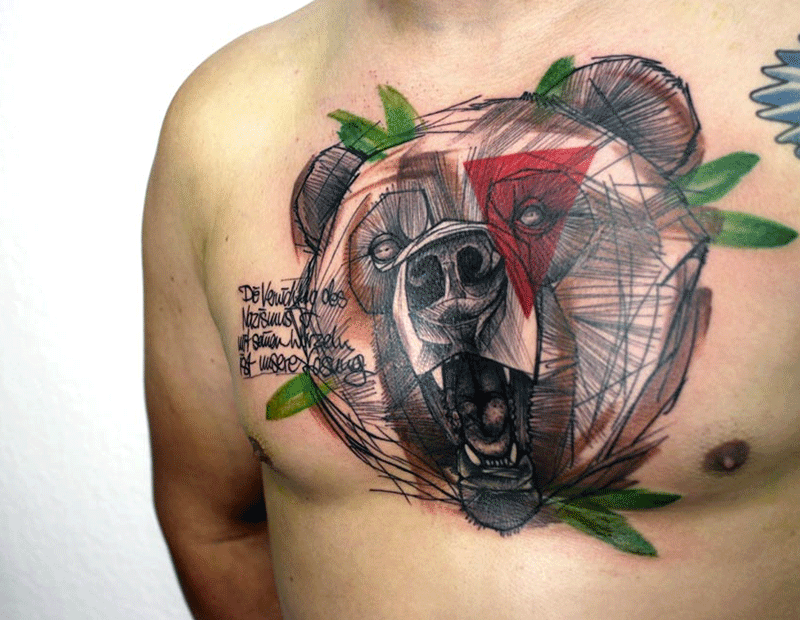
The Origins and Evolution of German Tattoos
Tattooing has been a part of German tradition since ancient times, with various tribes using it as a symbol of identity, status, and protection. Germanic warriors often had tattoos of animals, such as wolves or bears, reflecting their courage, strength, and connection with nature. Over time, as Christianity spread throughout Germany, tattoos became less common, as they were seen as pagan symbols. However, despite being banned by the church, tattoos continued to be used as a form of rebellion and expression among sailors, criminals, and other marginalized groups.
In the 19th century, German tattoos experienced a revival, with many artists incorporating traditional German motifs into their designs. These included symbols like eagles, lions, and skulls, along with phrases in the Gothic script. Today, German tattoos have evolved to include a wide range of designs, from traditional folk art to modern interpretations of German history and culture.
Popular German Tattoo Designs and Their Meanings
Eagle
German tattoos are a popular form of body art that often incorporate cultural and historical motifs. These tattoos are not only aesthetically pleasing but also hold significant meaning for the people who choose to get them. One of the most popular motifs in German tattoo art is the eagle.
The eagle symbolizes power, freedom, and national pride. It is a strong and majestic bird that has been used as a symbol in many cultures throughout history. In Germany, the eagle holds a particularly special place as it is considered the national symbol. The eagle has been used prominently on flags and coat of arms throughout German history, representing the strength and unity of the German people.
The use of the eagle motif in German tattoos can be traced back to the medieval period when knights would adorn themselves with eagle symbols to signify their bravery in battle. Over time, the eagle became synonymous with strength, courage, and honor, making it an ideal choice for those seeking to express these values through body art.
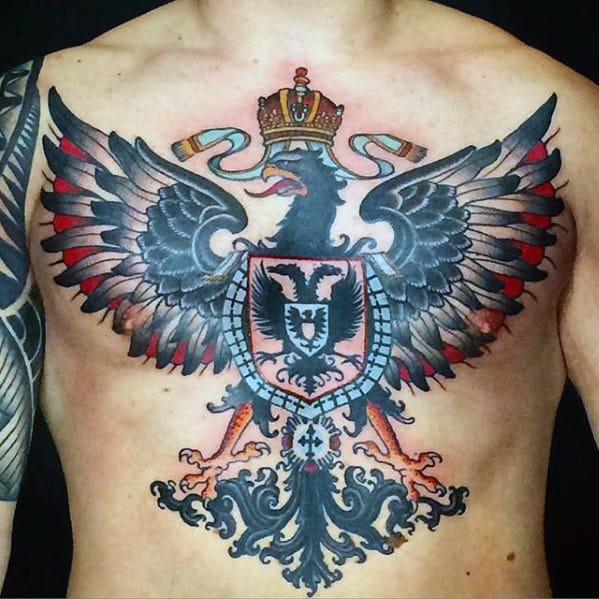
In addition to its historical significance, the eagle also represents personal growth and transformation. Many Germans get eagle tattoos as a way to mark important milestones or accomplishments in their lives. The eagle serves as a reminder of their strength and resilience, inspiring them to continue pushing forward in the face of adversity.
There are many different styles and variations of eagle tattoos in German culture. Some people opt for realistic depictions of the bird, while others prefer more abstract or stylized designs. The eagle may be depicted alone or alongside other symbols such as the German flag or the Iron Cross.
Ultimately, the choice of design and placement of a German eagle tattoo is a highly personal one. For some, it may represent a connection to their heritage and a sense of national pride. For others, it may simply be a beautiful and meaningful piece of body art that carries deep personal significance.
In conclusion, German tattoos featuring the eagle motif are deeply rooted in the country’s history and culture. They hold significant meaning for those who choose to get them, representing strength, courage, and national pride. Whether as a symbol of personal growth or connection to heritage, German eagle tattoos are a powerful form of body art that continue to inspire individuals to this day.
Iron Cross
German tattoos have become increasingly popular among tattoo enthusiasts, and many of these designs are rooted in the country’s rich history and culture. These tattoos often have deep meanings that reflect the wearer’s personal values, beliefs, or heritage.
One of the most iconic German tattoo designs is the Iron Cross, which represents bravery, honor, and patriotism. This design has a long and fascinating history that dates back to the early 19th century when it was first created by King Friedrich Wilhelm III in 1813.
At the time, Germany was facing Napoleon’s army, and King Friedrich Wilhelm III wanted to create a symbol that would inspire his soldiers to fight bravely and honorably. He designed the Iron Cross as a medal to be awarded to soldiers who displayed exceptional courage or service to their country.
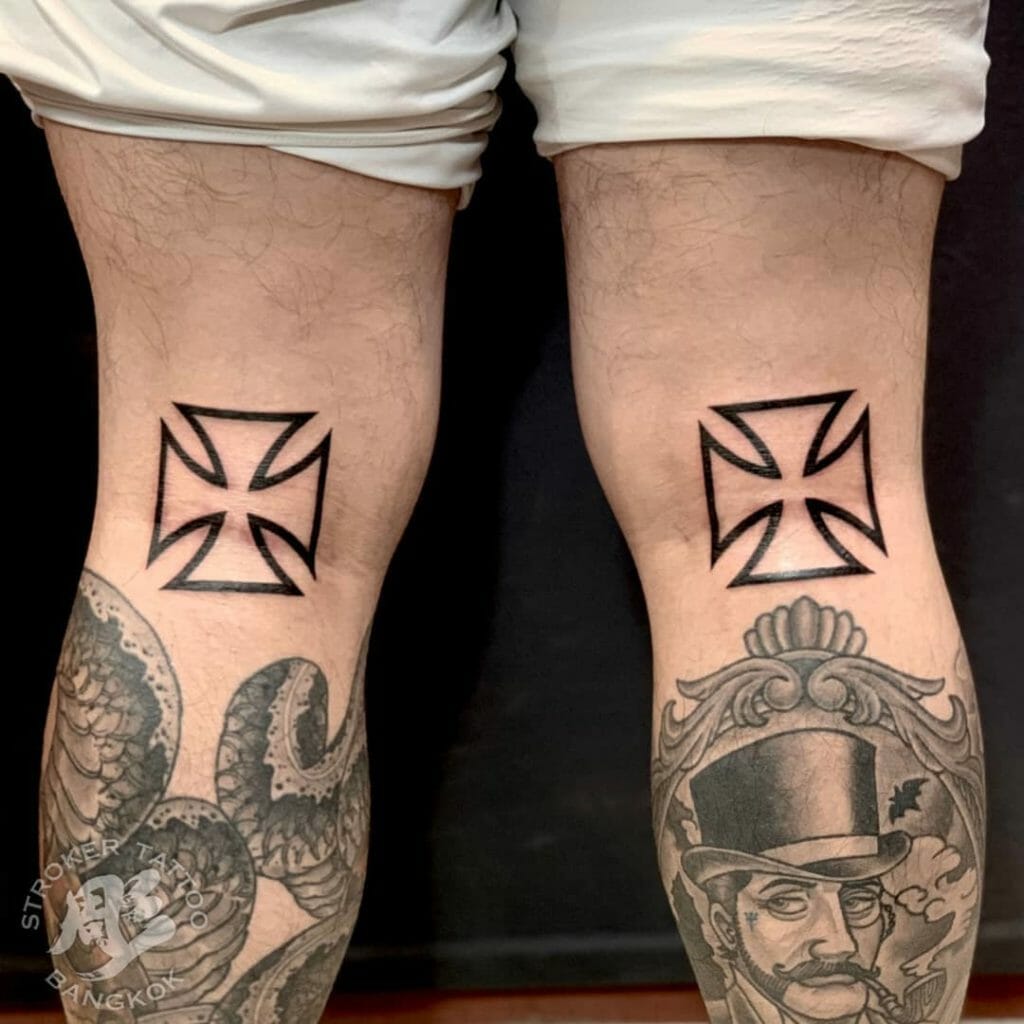
The Iron Cross quickly became one of the most prestigious military honors in Germany, and it was awarded numerous times during World War I and World War II. After the Second World War, the Iron Cross fell out of favor due to its association with the Nazi regime, but it has since regained popularity as a tattoo design.
Today, the Iron Cross is a popular tattoo design for both men and women, and it can be found in a range of sizes, styles, and colors. Many people choose to get an Iron Cross tattoo as a way to show their respect for Germany’s military history or to honor a family member who served in the armed forces.
However, it’s essential to note that the Iron Cross has been co-opted by white supremacist groups in recent years, and some people may associate the symbol with hate and bigotry. It’s crucial to research the meaning behind any tattoo design thoroughly and understand how it may be perceived by others before deciding to get inked.
In conclusion, German tattoos like the Iron Cross design represent bravery, honor, and patriotism. They hold significant historical and cultural significance and are popular among people who want to pay homage to their German heritage or show their respect for the country’s military history. However, it’s essential to be aware of any negative connotations associated with certain tattoo designs and to make an informed decision before getting inked.
Germanic Runes
German tattoos are a popular form of body art that incorporates Germanic runes, symbols, and motifs into the design. These tattoo designs often carry deep meanings and represent various aspects of German culture and history.
Germanic runes, an ancient writing system used by Germanic peoples for centuries, have been incorporated into German tattoo designs for their symbolic value. Each rune has its own meaning, which can be interpreted in different ways depending on the context in which it is used.
One of the most popular Germanic runes used in tattoos is Algiz. This symbol represents protection and defense, making it a popular choice for those seeking to convey a sense of strength or security. The Algiz rune is often depicted as a stylized image of a human figure with upraised arms, representing the power of protection.
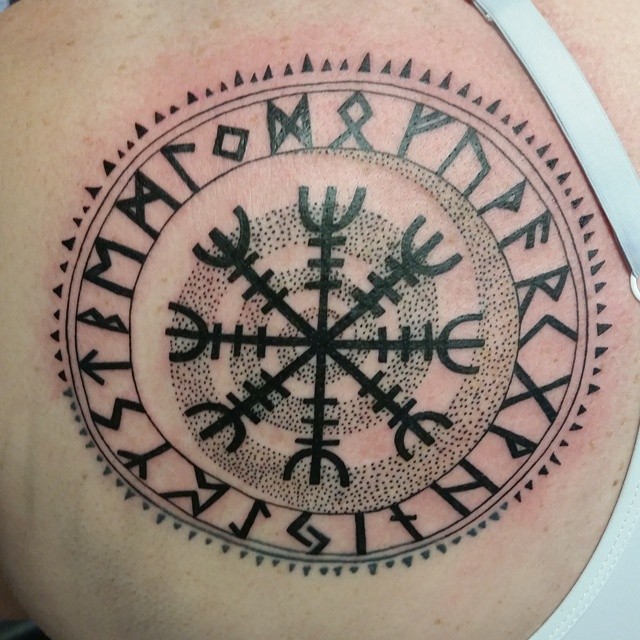
Another popular Germanic rune used in tattoos is Tiwaz. This symbol represents strength and victory, making it a popular choice for athletes, warriors, and anyone seeking to convey a sense of personal power or triumph over adversity. The Tiwaz rune is often depicted as an arrow pointing upward, representing the ascent to victory.
Other Germanic runes commonly used in tattoos include Fehu, which symbolizes wealth and prosperity; Inguz, which represents fertility and growth; and Raido, which stands for travel and journey.
In addition to runes, German tattoo designs may incorporate other symbols and motifs associated with German culture and history. For example, the black eagle, which has been a symbol of German nationalism since the Middle Ages, is often used in tattoo designs to represent pride in German heritage.
Similarly, the Iron Cross, a military decoration that originated in Prussia in the 19th century, is often used in German tattoo designs as a symbol of courage, honor, and loyalty.
Overall, German tattoos offer a powerful way to express one’s identity, values, and cultural heritage through body art. Whether incorporating runes, symbols, or motifs associated with German culture, these tattoos can convey a range of meanings and emotions, from strength and protection to pride and honor.
Skulls
German tattoos are a unique and significant form of body art that have been gaining popularity throughout the world. German tattoos often incorporate traditional and cultural elements, such as iconic symbols, phrases, and images that represent their heritage. One such symbol that has become prevalent in German tattoo designs is the skull.
Skulls are an ancient symbol that have been used by various cultures throughout history to convey different meanings. In Germany, skulls are often used in tattoo designs to represent death and rebirth. This symbolism traces back to the Germanic tribes, who believed that death was not the end but rather the beginning of a new journey into the spiritual realm.

In German culture, skulls are seen as a symbol of liberation from the physical world and moving into the spiritual realm. This belief stems from the concept of “Tod und Leben,” or “death and life,” which refers to the cycle of birth, death, and rebirth. The skull represents the transition from life to death and the beginning of a new spiritual journey.
German tattoos featuring skulls can also represent the idea of facing mortality and embracing the inevitability of death. It is a reminder to live life to the fullest and make the most of every moment. The design may feature other elements, such as flowers, wings, or religious symbols, to add depth and meaning to the piece.
Another popular design incorporating skulls in German tattoos is the “Totenkopf” or “death’s head.” This symbol was used by the Nazis during World War II and is often associated with the SS (Schutzstaffel) organization. However, in modern times, the Totenkopf has been adopted by various subcultures, including bikers, metalheads, and goths. In these contexts, the symbol is often used as a representation of rebellion, freedom, and non-conformity.
In conclusion, German tattoos featuring skulls hold deep cultural significance and represent various beliefs and ideas, including death, rebirth, spirituality, and embracing mortality. These designs have become popular among people worldwide, not only for their aesthetic appeal but also for the powerful symbolism they convey.
Roses
German tattoos have a rich history which dates back centuries, with various designs and symbols used to represent different aspects of the country’s culture and heritage. One of the most popular motifs in German tattoo art is the rose, which has been used for centuries to symbolize love, beauty, and passion.
Roses are often depicted in bold red and black colors in German tattoo art, giving them a striking appearance that instantly catches the eye. These colors not only provide contrast but also add depth and dimension to the tattoo, making it look more realistic.
In German culture, roses are also associated with the concept of “Vergänglichkeit,” which translates to “transience.” This idea refers to the fleeting nature of life and the impermanence of all things. However, despite this notion, roses are still considered a symbol of enduring love and beauty.
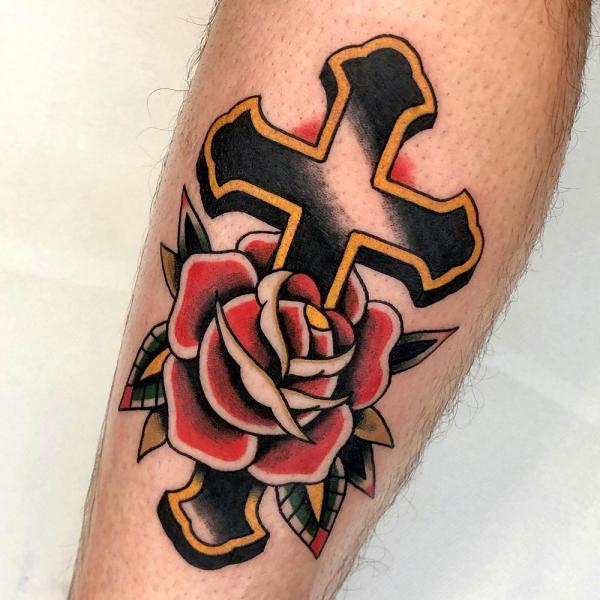
The significance of roses in German culture can be traced back to the Middle Ages when they were often used as a decorative element in tapestries and artwork. During this time, roses were also used to symbolize the Virgin Mary and her purity.
Over time, the meaning of roses in German tattoo art has evolved to include notions of love, beauty, passion, and even rebellion. Some tattoo enthusiasts choose to incorporate thorns into their rose tattoos as a symbol of strength and resilience, while others opt for a more minimalist design that focuses solely on the beauty and elegance of the flower.
One interesting thing to note about German tattoo art is that it often incorporates elements of other cultures and traditions. For example, many German tattoo designs feature Celtic knots or Nordic runes, both of which have deep roots in ancient European culture.
Overall, German tattoos are a beautiful and meaningful way to pay tribute to one’s heritage and cultural background. Whether you choose to incorporate roses into your design or opt for a different symbol altogether, a German tattoo is sure to be a powerful and lasting expression of your identity and values.
How to Use German Tattoos and Meanings
If you are interested in getting a German tattoo, there are many ways to use these designs to express your personality and cultural heritage. You can choose a traditional German tattoo design, such as an eagle or Iron Cross, or create a custom design that incorporates elements of German culture that are meaningful to you.
For example, if you have German ancestry, you might consider incorporating symbols or phrases that reflect your family history. Alternatively, you might choose a German phrase or quote that has special significance to you. Whatever design you choose, be sure to work with a reputable tattoo artist who is experienced in creating German tattoos.
Examples of German Tattoos and Meanings
Here are some examples of German tattoos and their meanings:
- A tattoo of the German flag, representing national pride and heritage.
- A tattoo of a Germanic rune, such as Algiz, symbolizing protection and defense.
- A tattoo of an eagle, representing strength, freedom, and power.
- A tattoo of a skull, representing death and rebirth.
- A tattoo of the Iron Cross, representing bravery, honor, and patriotism.
Comparisons for German Tattoos and Meanings
German tattoos can be compared to other cultural tattoos, such as Japanese or Celtic designs. While each culture has its unique motifs and symbolism, German tattoos are known for their bold lines, dark colors, and intricate details. German tattoos also have a rich history and cultural significance that makes them a popular choice among those who appreciate German heritage.
Tips and Advice for Getting German Tattoos
If you are interested in getting a German tattoo, here are some tips and advice to keep in mind:
- Research the different types of German tattoos and meanings before choosing a design.
- Find a reputable tattoo artist who is experienced in creating German tattoos.
- Consider incorporating your personal history or family heritage into the design.
- Discuss placement and size with your tattoo artist before getting inked.
- Take care of your tattoo after it is done by following proper aftercare instructions.
Conclusion
German tattoos are a beautiful and meaningful way to embrace German heritage and express your personality. Whether you choose a traditional German design or create a custom tattoo that reflects your personal history, getting a German tattoo can be an excellent way to showcase your love for all things German. By understanding the rich history and significance of German tattoos, you can make an informed decision and select a design that truly represents who you are.

I am Harvey Berry, a tattoo enthusiast who has immersed himself in the diverse world of ink, passionately exploring the beauty and artistry within each tattoo. My mission extends beyond uncovering the aesthetics of tattooing; it involves sharing in-depth knowledge across all aspects of this art form.
Fueled by genuine curiosity and love for every facet of tattooing, I have diligently crafted well-researched articles, with a special focus on the Tattoo Meaning of Impeccable Nest section. Here, my aim is to help the tattoo community gain a deeper understanding of the meanings and values embedded in each tattoo.
One of my primary goals is to encourage responsible decision-making when it comes to getting inked. I recognize that choosing to get a tattoo is a significant personal decision that requires careful consideration. Hence, I provide diverse resources covering the meaning of tattoos, the tattooing process, aftercare tips, and other valuable information.
Whether you are a seasoned tattoo enthusiast or embarking on your first exploration of the world of body art, I aspire to be a reliable resource for you at every step of your journey. I hope that my extensive knowledge of tattoos, especially in the Tattoo Meaning section, will assist you in finding inspiration to express yourself through the art of tattoos.
